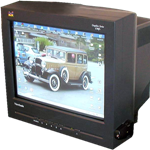 The other day we were looking at what we’re all looking at – screens – and being nostalgic. Then we realized there isn’t much to be nostalgic about.
The other day we were looking at what we’re all looking at – screens – and being nostalgic. Then we realized there isn’t much to be nostalgic about.
Here’s what we remember of the good old Cathode Ray Tube (CRT) screens that used to adorn our desktops:
- Backache – Would you rather carry around a 72-pound or a 24-pound (33 or 11 kg) 22-inch screen? We prefer the latter.
- Desktop real estate – We don’t miss having a hulk of a monitor on our desks.
- Skin burn – In cold climates, static electricity from CRT screens can give some individuals problems with this. We’re in a cold climate (Sweden).
- Dust magnets – Another side effect of the static electricity in CRT monitors is that they amass dust faster than you can wipe it off (well, almost).
- Screen burn – The phosphor in conventional CRT screens can make an image projected over a long time period stick, leaving a ghost image.
- Screen flicker – LCDs don’t “paint” their image as CRTs do and so you can avoid any risk of a flickering image. (Just look at a CRT screen out of the corner of your eye, which is more sensitive to motion.)
- Aussie or Viking screen – The difference in the Earth’s magnetic field between the Northern and Southern hemispheres can cause the electron beams in a CRT calibrated for the wrong hemisphere to be slightly skewed. Not that this matters to most people, but it’s a pretty funny consequence of how CRTs work.
- Good stuff inside – A vacuum tube that can implode, lead glass to isolate us from X-rays, high voltage, all combined inside the box. That’s all stuff we, as well as our environment, can do without.
- Energy consumption – At any time except during the coldest winter (when you might relish the heat at the back of a CRT screen), why use more than double the energy?
Now, of course, we have to admit that the trusted CRT technology still provides a very strong performance in areas like contrast, color fidelity and viewing angle. But even considering that, we still prefer our flat friends.
Do you think we are being too hard on CRT screens? Let us know in the comments.
Image from Wikimedia Commons


























